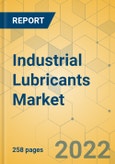Speak directly to the analyst to clarify any post sales queries you may have.
OPPORTUNITIES & TRENDS
- Rising trend of bio-based industrial lubricants
DRIVERS
- Rapid Industrialization in BRICS nation.
RESTRAINTS
Used industrial lubricants are considered a serious pollution problem due to illegal dumping or improper disposal, resulting in groundwater, surface water, and soil contamination. These used lubricants cannot be directly combusted without pre-treatment. They are subjected to environmental restrictions since they may contain toxic and hazardous residues such as metal and metalloid particles. These chlorinated compounds may be released into the atmosphere. Used lubricant should be instead recycled instead of treated as waste. The value of lubricants largely depends on quality which is determined in terms of the amount of contamination by water, solid, or other fluids.Industrial lubricants can be retreated by various processes such as reprocessing, re-refining, and destruction.
SEGMENT REVIEW
- The oil used for lubrication in industrial machinery and equipment is called industrial oil. Industrial oils include hydraulic fluid, compressor oil, refrigeration oil, cylinder oil, spindle oil, and transformer oil. Industrial oils are used to improve the performance of industrial machinery and equipment and protect them against damage during operations.
- Industrial lubricants are used in manufacturing, power generation, metal & mining, and construction industries. High growth in the metal & mining, and power generation industry is one of the main drivers in the industrial lubricants market. As in the power generation industry, industrial lubricants are widely used in power generation plants such as coal power plants, gas turbine power plants, hydroelectric power plants, natural gas engines, nuclear energy power plants, and wind energy plants.
Market Segmentation by Product Type
- Industrial Oil
- Metalworking Fluid
- Process Oil
- Grease
Market Segmentation by End-Use
- Manufacturing
- Power Generation
- Metal & Mining
- Construction
- Others
Market Segmentation by Geography
- North America
- US
- Canada
- Europe
- Germany
- UK
- France
- Italy
- Spain
- Russia
- Rest of Europe
- APAC
- China
- India
- Japan
- Australia
- South Korea
- Rest of APAC
- Latin America
- Brazil
- Mexico
- Rest of Latin America
- Middle East & Africa
- Saudi Arabia
- South Africa
- UAE
- Rest of the Middle East & Africa
COMPANY & STRATEGIES
- The competitive scenario in the global industrial lubricants market is currently intensifying. In the industrial lubricant market, the initial capital investment is very high in setting up a manufacturing plant and developing a supply chain network. In addition, there are many well-established players in the industrial lubricants market, and producing industrial lubricants from crude oil and other additives is a very complex process.
- The industrial lubricants market consists of major global multinational players such as Shell plc (UK), ExxonMobil Corporation (US), Chevron Corporation (US), Castrol (UK), and Total Energies (France) in the industrial lubricants market. The major players focus on innovation, product diversification & entering new markets.
- The industrial lubricants market is provided for the forecast years 2022 to 2027 and the base year of 2021. The market is segmented as per Type, End-user, and Geography for the years considered. The report provides a holistic approach to the Industrial Lubricants industry to enable customers to analyze the market efficiently.
Key Vendors:
- Castrol Limited
- Chevron Corporation
- ExxonMobil
- Shell plc
- Total Energies
Other Prominent Vendors
- Clariant
- Eneos Corporation
- ENI
- Fuchs
- Gazpromneft - Lubricants Ltd
- Gulf Oil Lubricants India Ltd
- Hindustan Petroleum Corporation Limited
- Idemitsu Kosan Co. Ltd
- Indian Oil Corporation limited
- Klüber Lubrication
- Lukeoil
- Motul
- Morris lubricants
- Petronas Lubricants International
- Petro Canada Lubricants
- Philips 666
- Repsol
- Rosneft lubricants
- Sinopec Corporation
- Valvoline
KEY QUESTIONS ANSWERED:
1. WHAT IS THE MARKET SIZE OF THE INDUSTRIAL LUBRICANTS MARKET?2. WHAT IS THE GROWTH RATE OF THE INDUSTRIAL LUBRICANTS MARKET?
3. WHO ARE THE KEY PLAYERS IN THE INDUSTRIAL LUBRICANTS MARKET?
Table of Contents
Companies Mentioned
- Castrol Limited
- Chevron Corporation
- ExxonMobil
- Shell plc
- Total Energies
- Clariant
- Eneos Corporation
- ENI
- Fuchs
- Gazpromneft - Lubricants Ltd
- Gulf Oil Lubricants India Ltd
- Hindustan Petroleum Corporation Limited
- Idemitsu Kosan Co. Ltd
- Indian Oil Corporation limited
- Klüber Lubrication
- Lukeoil
- Motul
- Morris lubricants
- Petronas Lubricants International
- Petro Canada Lubricants
- Philips 666
- Repsol
- Rosneft lubricants
- Sinopec Corporation
- Valvoline
Methodology
Our research comprises a mix of primary and secondary research. The secondary research sources that are typically referred to include, but are not limited to, company websites, annual reports, financial reports, company pipeline charts, broker reports, investor presentations and SEC filings, journals and conferences, internal proprietary databases, news articles, press releases, and webcasts specific to the companies operating in any given market.
Primary research involves email interactions with the industry participants across major geographies. The participants who typically take part in such a process include, but are not limited to, CEOs, VPs, business development managers, market intelligence managers, and national sales managers. We primarily rely on internal research work and internal databases that we have populated over the years. We cross-verify our secondary research findings with the primary respondents participating in the study.

LOADING...








